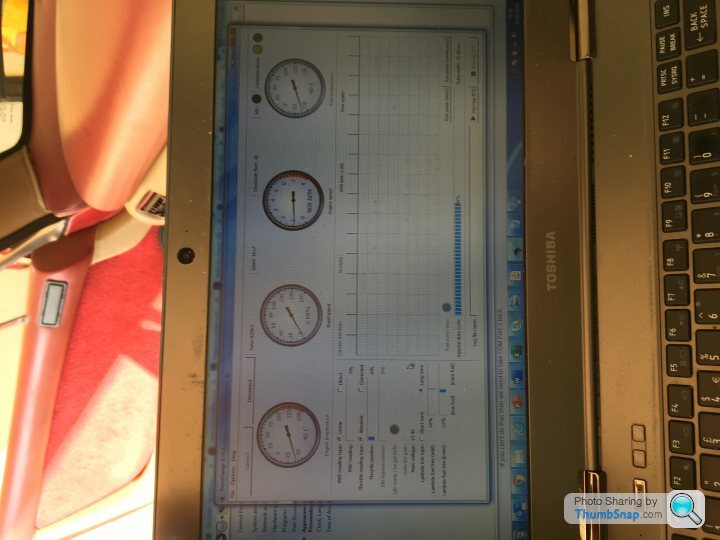Discussion
Paul,
You say the fault has always been cured by lying the ECU on the floor?
The fact that when the ECU is lying flat the fault disappears is still key I feel.
If it is not a an intermittent connection perhaps changing the ECU position is causing some interference to the ECU to be reduced when lying flat,
Mark, " Blitzracing" on here would know if this was a possibility. It seems an unlikely cause as the ECU case is alloy and presumably earthed.
I do not suppose there is anything on the engine side of the bulkhead pushing out hefty electrical spikes?
You say the fault has always been cured by lying the ECU on the floor?
The fact that when the ECU is lying flat the fault disappears is still key I feel.
If it is not a an intermittent connection perhaps changing the ECU position is causing some interference to the ECU to be reduced when lying flat,
Mark, " Blitzracing" on here would know if this was a possibility. It seems an unlikely cause as the ECU case is alloy and presumably earthed.
I do not suppose there is anything on the engine side of the bulkhead pushing out hefty electrical spikes?
Edited by Loubaruch on Friday 26th July 12:44
Just been reading this thread with interest, I've had a very similar problem with my 94 Chimaera lately which I 'think' I've finally cured.
For a while now I would occasionally get a little rough running, poor idle, etc, which would often 'fix' itself.
More recently some of the issues got worse, the idle was all over the place and it would cut out.
I was getting numerous fault codes including Low Fuel Pressure, Stepper Motor, Lambdas, AFM, and then last week just after getting it MOT'd it started getting worse, she was running like a pig as well as sounding like it was only firing on 5 or 6 cylinders with a bad petrol smell.
Whilst messing with the rats nest of wiring in the passenger footwell I found that waggling the ECU would cure the issue and she'd run lovely again. Also, depending on how I positioned the ECU in the footwell I could make the car instantly cut out. There was definitely a loose connection somewhere.
I removed the plastic shroud from the ECU plug to check for loose wires but everything seemed fine, so I reconnected it with the shroud removed to access the back of the terminals and do some continuity checks with the ECU connected.
Without the shroud fitted, or the rubber sealing gasket that it bottoms out onto, the ECU plug engaged a little deeper on the pins, only by a millimetre or two, but enough to engage the pins further and make a better connection.
The car instantly ran beautifully - one moment it was ticking over as lumpy as hell, and as soon as the connector was pushed further home it was instantly back to running on all 8 and sounding lovely.
I drove it like this for a few days with the ECU and wiring still spread all over the passenger footwell just in case I needed quick access to mess with it again but it ran perfectly, so I've now refitted it all back in place next to the battery but this time with the plastic shroud removed/connector block pushed fully home, and the wiring straightened out instead of being bent round 90 degrees to take some of the strain off the wires.
I've been driving it like this all week in 30+ degree heat and it hasn't missed a beat.
If it continues to run fine like this I'll wrap some self-amalgamating tape around the base of the ECU plug just to prevent dust ingress now the original rubber seal isn't in place, and cut an opening in the top of the plastic ECU shroud to allow the wires to come straight out of the ECU instead of being bent round.
Steve.
For a while now I would occasionally get a little rough running, poor idle, etc, which would often 'fix' itself.
More recently some of the issues got worse, the idle was all over the place and it would cut out.
I was getting numerous fault codes including Low Fuel Pressure, Stepper Motor, Lambdas, AFM, and then last week just after getting it MOT'd it started getting worse, she was running like a pig as well as sounding like it was only firing on 5 or 6 cylinders with a bad petrol smell.
Whilst messing with the rats nest of wiring in the passenger footwell I found that waggling the ECU would cure the issue and she'd run lovely again. Also, depending on how I positioned the ECU in the footwell I could make the car instantly cut out. There was definitely a loose connection somewhere.
I removed the plastic shroud from the ECU plug to check for loose wires but everything seemed fine, so I reconnected it with the shroud removed to access the back of the terminals and do some continuity checks with the ECU connected.
Without the shroud fitted, or the rubber sealing gasket that it bottoms out onto, the ECU plug engaged a little deeper on the pins, only by a millimetre or two, but enough to engage the pins further and make a better connection.
The car instantly ran beautifully - one moment it was ticking over as lumpy as hell, and as soon as the connector was pushed further home it was instantly back to running on all 8 and sounding lovely.
I drove it like this for a few days with the ECU and wiring still spread all over the passenger footwell just in case I needed quick access to mess with it again but it ran perfectly, so I've now refitted it all back in place next to the battery but this time with the plastic shroud removed/connector block pushed fully home, and the wiring straightened out instead of being bent round 90 degrees to take some of the strain off the wires.
I've been driving it like this all week in 30+ degree heat and it hasn't missed a beat.
If it continues to run fine like this I'll wrap some self-amalgamating tape around the base of the ECU plug just to prevent dust ingress now the original rubber seal isn't in place, and cut an opening in the top of the plastic ECU shroud to allow the wires to come straight out of the ECU instead of being bent round.
Steve.
Some very interesting comments
To Steve I would be very grateful if you would update me as you hopefully progress, I will certainly try that as soon as I get home, it will be a good excuse for a drive
As for Loubaruch interference possibility I will check the case earthing, and should I admit to still having the original metal plug extenders??, I will fire her up at night and look for any sparks, but an interesting theory
Finally thanks to Dr Mike Oxgreen for a new word to explain a very unusual plug numbering system that I have never seen before, just not sure when I will ever use this new knowledge, but we will see
Thanks guys for some directions that I had not considered
To Steve I would be very grateful if you would update me as you hopefully progress, I will certainly try that as soon as I get home, it will be a good excuse for a drive
As for Loubaruch interference possibility I will check the case earthing, and should I admit to still having the original metal plug extenders??, I will fire her up at night and look for any sparks, but an interesting theory
Finally thanks to Dr Mike Oxgreen for a new word to explain a very unusual plug numbering system that I have never seen before, just not sure when I will ever use this new knowledge, but we will see
Thanks guys for some directions that I had not considered
I have tried out the previous suggestions, checked that the ecu is earthed, the internals are ok, removed the plug cover and seal, but still no change, so In the absence of a scope I connected up some multimeters to measure the voltage to the injectors, measured st the supply from the main relay as well as the ecu ground switching on pins 11 and 13, when driving normally this results in a supply voltage of high 13s and the switching being low 13v at Rickover and dropping as the revs rise, circa 10v at 3000rpm, yesterday while ticking over it started to run rough while in the garage, as soon as it started I get the below 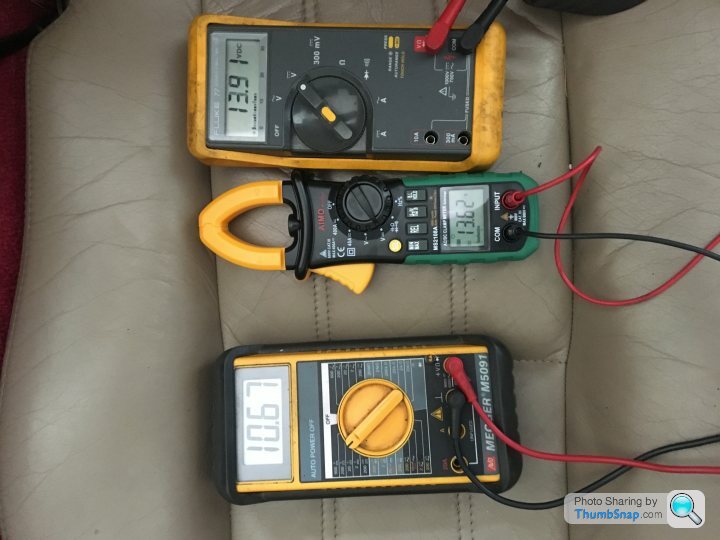
The left meter is the left bank of injectors, central is the right bank, right is supply voltage
After maybe 1 or 2 minutes I get the below signals
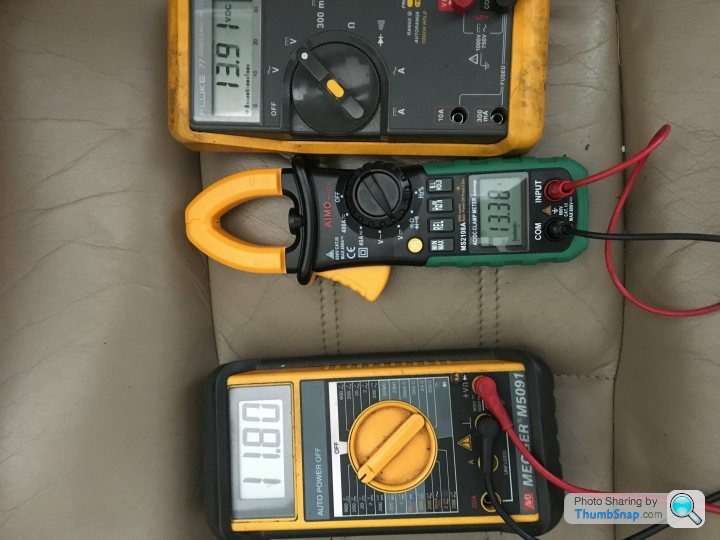
Then onto this
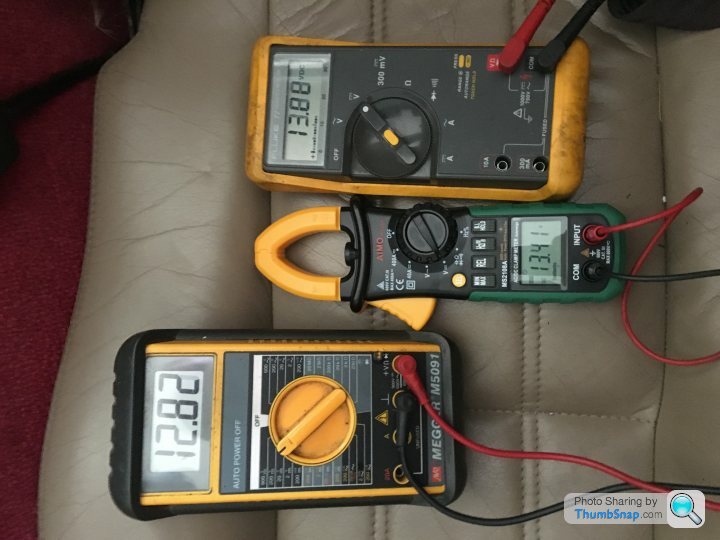
At this stage it coughing and spluttering as if it’s nearly working, then finally this when it’s running smoothly again
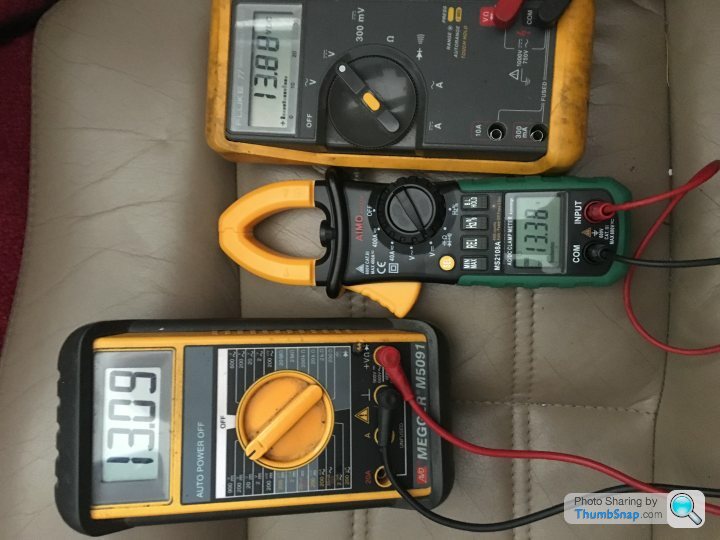
So it looks like the left bank is firing for too long and flooding, then after a few minutes it gradually resets back to normal, this is the way it always happens and looks to be controlled in doing so, does anyone have any idea why the left bank decides it suddenly needs a lot more fuel than it should ??

The left meter is the left bank of injectors, central is the right bank, right is supply voltage
After maybe 1 or 2 minutes I get the below signals

Then onto this

At this stage it coughing and spluttering as if it’s nearly working, then finally this when it’s running smoothly again

So it looks like the left bank is firing for too long and flooding, then after a few minutes it gradually resets back to normal, this is the way it always happens and looks to be controlled in doing so, does anyone have any idea why the left bank decides it suddenly needs a lot more fuel than it should ??
You cant get any sensible reading from the injectors with a DVM to measure the injector pulse width. Id take two steps back and see what RoverGauge sees as the ECU voltage as and injector timings to start with. The ECU is smart enough to alter injector opening periods if the supply voltage varies. The left and right banks are fuelled slightly differently as the airflow is not uniform with the plenum on one side.
as for RoverGauge....
Check fault codes, and check long and short term trim values. Long term is pretty static and should be less than 100%. Short term should cycle around the mid point- run the car at say 1500 rpm to check this. The TVR set up has a nasty habit of the trim not cycling at all at idle, or very slowly when the gas velocities are low. There is an excellent logging facility on RoverGauge so firstly set up the sensors you want to read. These are:
RPM
Short term trim
AFM
Throttle pot
voltage
Then turn on the logging and go for a run. It would be great if it fails when you do and we can catch it. I can pull the logs to bits for you.
as for RoverGauge....
Check fault codes, and check long and short term trim values. Long term is pretty static and should be less than 100%. Short term should cycle around the mid point- run the car at say 1500 rpm to check this. The TVR set up has a nasty habit of the trim not cycling at all at idle, or very slowly when the gas velocities are low. There is an excellent logging facility on RoverGauge so firstly set up the sensors you want to read. These are:
RPM
Short term trim
AFM
Throttle pot
voltage
Then turn on the logging and go for a run. It would be great if it fails when you do and we can catch it. I can pull the logs to bits for you.
Edited by blitzracing on Wednesday 21st August 17:58
Thanks Blitzracing, I will try and do that, for my understanding, what are “short and long term trim “
The difficulty is going to be catching it with the laptop connected, I guess I will need to connect every time and run and maybe only start logging when the problem happens and stop it when it clears, is there a time stamp with the log so we can compare against the time when the problem starts and stops ??
I seem to recall discussions about running RG on a tablet, is that a possibility ??
The difficulty is going to be catching it with the laptop connected, I guess I will need to connect every time and run and maybe only start logging when the problem happens and stop it when it clears, is there a time stamp with the log so we can compare against the time when the problem starts and stops ??
I seem to recall discussions about running RG on a tablet, is that a possibility ??
The trim values are the amount of correction the ECU has to make to keep the fuel air ratio at the correct level, and tells you a lot about the general engine / ECU state if the trims are wrong. Long term is the base fuelling level, sort term is the instantaneous adjustments needed to make the catalyst work.Yes you will need to be running RoverGauge logging if you want to catch a live error, but even big log files dont use a lot of computer space as they are simple text files, so just start logging, and then go for a drive. They are almost impossible to read without a bit of sorting in excel, but the RoverGauge full instructions found on the CD explain how to do it, or I can do it for you if you mail me the logs.
Ive done a page on how the fuelling works here:
http://www.g33.co.uk/pages/technical-fuel-injectio...
RoverGauge will run quite happily on a windows tablet, but you are likely to need a conversion plug to convert the full size USB cable connector to the smaller ones used on a tablet. There is an android version of RoverGauge, but its harder to set up and use, but it will run on a phone if you want to spend the time setting it up.
https://www.pistonheads.com/gassing/topic.asp?h=0&...
Do check for fault codes in RoverGauge though, Id think a fault as bad as yours should flag something.
Ive done a page on how the fuelling works here:
http://www.g33.co.uk/pages/technical-fuel-injectio...
RoverGauge will run quite happily on a windows tablet, but you are likely to need a conversion plug to convert the full size USB cable connector to the smaller ones used on a tablet. There is an android version of RoverGauge, but its harder to set up and use, but it will run on a phone if you want to spend the time setting it up.
https://www.pistonheads.com/gassing/topic.asp?h=0&...
Do check for fault codes in RoverGauge though, Id think a fault as bad as yours should flag something.
Edited by blitzracing on Thursday 22 August 09:52
Can I be a little more basic for you than Marks answer.
The ECU has a map in it that says this is the amount of fuel the engine needs for any given combination of revs, air flow (into the engine), throttle position, temperature etc.
But the lambda sensors look at the exhaust gas and say 'sorry you got that wrong' and make minor changes by the second and this is the 'short term trim' bouncing around the mid point.
The ECU looks at what the Lambdas are doing and decide they have a valid point but are having to work quite hard and make large corrections because the map is a fair way out so they monitor the Lambda results over a longer period. It then makes a larger correction to the map so that the short term trim has an easier job and can make finer changes.
Steve
The ECU has a map in it that says this is the amount of fuel the engine needs for any given combination of revs, air flow (into the engine), throttle position, temperature etc.
But the lambda sensors look at the exhaust gas and say 'sorry you got that wrong' and make minor changes by the second and this is the 'short term trim' bouncing around the mid point.
The ECU looks at what the Lambdas are doing and decide they have a valid point but are having to work quite hard and make large corrections because the map is a fair way out so they monitor the Lambda results over a longer period. It then makes a larger correction to the map so that the short term trim has an easier job and can make finer changes.
Steve
Thanks for that Steve, I will connect RG and hope to record on its next rough running although due to the intermittent nature it could be some time before I respond again, but one question, the Lambdas are individual per bank, is it possible that s dodgy signal from one of these could cause such a big fuelling error ??
Paulprior said:
.............. is it possible that s dodgy signal from one of these could cause such a big fuelling error ??
Yes it is. In a workshop we would swap them over and see if we could move the fault to the other side but you do need a special tool to remove the Lambda sensors so not an easy DIY task.Steve
QBee said:
Paul, if you get to the point of wanting to test your lambdas, I have a pair of used lambdas that used to be in my car and worked fine, before i changed the ECU to Emerald.
I can easily post them to you
Hi PaulI can easily post them to you
Like QBee (who helped me out recently, thanks again !!) I have just been through similar excercise and have loads of known good parts that could be used for test purposes. FWIW mine was a bent valley gasket covering inlets 5 and 7.....my fault
Following the comments above i have swapped over the Lambda sensors and been driving around with just 2 multimeters connected to measure the injector signal as best as possible, an indication at least, as well as having RG hooked up most of the time, i have covered around 500 miles without any fault at all until yesterday, about a mile from home after a great days driving, Lake Bala, the Evo triangle, Horseshoe pass and the Ponderosa.
Un fortunately i didnt have RG connected up yesterday, the missus is getting a bit fed up with laptops and multimeters, and when the fault happened the meters were on the floor and she had somehow pulled the leads out, so i stopped quickly, connected the leads, left bank has a lower voltage, left hand manifold colder
Rg shows no alarm of any sort, from that can i conclude that they are good, especially after swapping them around, what would the RG or the ECU need to see to set an alarm?.
So Hypothetically what could be my possibilities if i assume that i am overfuelling on the left bank and the time taken running rough is the time the ECU takes to reset its long term trim to be in the right area?, if that is a possibility what could cause the issue to start with, a dodgy sensor cable from Lambda to ECU ???, if so how long does that signal need to be low, just a few seconds or less for a bad connection???
Any thoughts welcome as always
Un fortunately i didnt have RG connected up yesterday, the missus is getting a bit fed up with laptops and multimeters, and when the fault happened the meters were on the floor and she had somehow pulled the leads out, so i stopped quickly, connected the leads, left bank has a lower voltage, left hand manifold colder
Rg shows no alarm of any sort, from that can i conclude that they are good, especially after swapping them around, what would the RG or the ECU need to see to set an alarm?.
So Hypothetically what could be my possibilities if i assume that i am overfuelling on the left bank and the time taken running rough is the time the ECU takes to reset its long term trim to be in the right area?, if that is a possibility what could cause the issue to start with, a dodgy sensor cable from Lambda to ECU ???, if so how long does that signal need to be low, just a few seconds or less for a bad connection???
Any thoughts welcome as always
Paulprior said:
I have tried out the previous suggestions, checked that the ecu is earthed, the internals are ok, removed the plug cover and seal, but still no change, so In the absence of a scope I connected up some multimeters to measure the voltage to the injectors, measured st the supply from the main relay as well as the ecu ground switching on pins 11 and 13, when driving normally this results in a supply voltage of high 13s and the switching being low 13v at Rickover and dropping as the revs rise, circa 10v at 3000rpm, yesterday while ticking over it started to run rough while in the garage, as soon as it started I get the below 
The left meter is the left bank of injectors, central is the right bank, right is supply voltage
After maybe 1 or 2 minutes I get the below signals

Then onto this

At this stage it coughing and spluttering as if it’s nearly working, then finally this when it’s running smoothly again

So it looks like the left bank is firing for too long and flooding, then after a few minutes it gradually resets back to normal, this is the way it always happens and looks to be controlled in doing so, does anyone have any idea why the left bank decides it suddenly needs a lot more fuel than it should ??
At what locations were the multimeters connected?
The left meter is the left bank of injectors, central is the right bank, right is supply voltage
After maybe 1 or 2 minutes I get the below signals

Then onto this

At this stage it coughing and spluttering as if it’s nearly working, then finally this when it’s running smoothly again

So it looks like the left bank is firing for too long and flooding, then after a few minutes it gradually resets back to normal, this is the way it always happens and looks to be controlled in doing so, does anyone have any idea why the left bank decides it suddenly needs a lot more fuel than it should ??
Gassing Station | Chimaera | Top of Page | What's New | My Stuff




